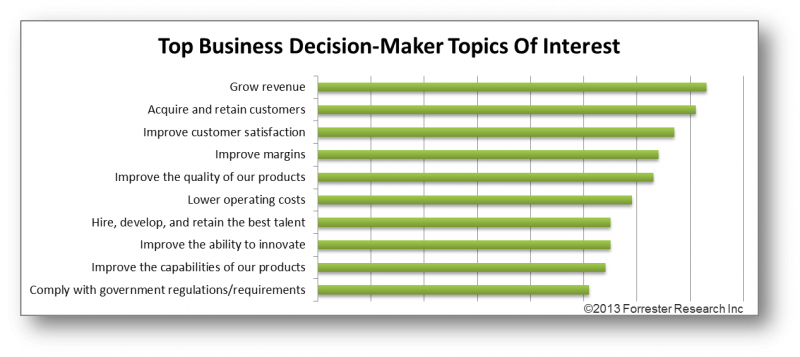Chasing KPIs That Matter
Is there a fundamental problem in today’s IT? I believe there is, and it’s this: IT decision-makers are too often focused on the wrong things.
In a recent study, Forrester examined the top priorities, topics, and terms from a variety of data sources for both business decision-makers and technology decision-makers. What we found was a very clear — and to my mind, troubling — distinction between these two groups.
Business decision-makers focus on topics like growing revenue, improving customer satisfaction, and hiring, developing, and retaining the best talent. By contrast, IT decision-makers focus on topics like improving project delivery performance, improving budget performance, and cutting IT costs.

The fact that IT decision-makers have so little focus on business outcomes is one of the main reasons IT is seen as disconnected from the rest of the business.
The only way for CEOs and CIOs to fix this is to begin to measure IT professionals more in terms of business-outcomes and less on project delivery and system uptime. In other words, we need to measure IT professionals using the same KPIs we use to measure leaders across the rest of the business. This means we must begin measuring IT’s impact on things like the change in customer satisfaction (that’s the company’s customer satisfaction and not IT’s internal “customers” as some groups like to refer to other employees in the company), or the increase in sales, or the ability to attract and retain top talent.
I’m not suggesting this shift is easy. This was again highlighted to me today in a conversation I had with a client who asked how they could connect someone who manages database tickets to business metrics. The answer in this case lies in a better understanding of the real business impact of each ticket — what is the business impact if it’s not fixed? What is the business impact if it takes twice as long to fix? For any company, every employee action should be connected back to a business/customer impact — after all, if you cannot do that, then you have to ask “why is this activity important?”
When I suggest these changes to IT leaders, all too often I hear objections like this: “We have no control over things like customer satisfaction.” The thing is, neither does anyone else in the organization — almost everyone in the organization, including the CEO, can only influence such metrics to a greater or lesser extent, but certainly not control them. The simple truth is that we can create more disruptive and innovative strategies by focusing everyone on the same business goals. And while the connection between IT and specific business outcomes like increasing sales may seem tenuous, IT professionals in today's businesses do play a pivotal role in delivering all business outcomes.
However, there is a little ray of sunshine on the horizon — at least a few of the topics between business decision-makers and IT decision-makers are connected: “Improve ability to innovate” and “align with business outcomes and drive innovation,” for example. But what is clear is that CIOs have a long way to go to move the thinking within IT away from “on-time, on-budget project delivery” to “improve the capabilities of our products” or “acquire and retain customers.”
Please post your thoughts and comments below.
For a daily update of news for CIOs around the Web, subscribe to CIO Update.
Next post: Sourcing Capabilities: What Big Business Can Learn From Startups
Previous post: 2013: The Year Of Digital Business